Algebra Mathematics
Consequences for Real Numbers
For any real numbers a and b, the following hold:
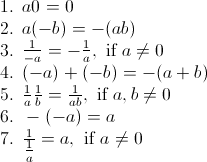
These equations are consequences of the properties of real numbers that we will frequently use in algebra. To make it easier to refer to them, they have been given descriptive names: Multiplication by Zero, Additive Inverse of a Product, Commutativity of Inverses, Additive Inverse of a Sum, Multiplicative Inverse of a Product, Additive Inverse of an Additive Inverse, and Multiplicative Inverse of a Multiplicative Inverse. The derivations of these equations are given below and should guide the reader in the proper methodology for algebra.
Derivations
Multiplication by Zero
This property says the product of any real number and zero is zero. The first equality follows by the property of the additive identity. The second equality follows from the property of additive inverses. For the third, we use additive associativity. In the fourth, we use the distributive property. The fifth follows from the additive identity. Finally, the sixth follows from the property of additive inverses. Note that, by commutativity, we see that 0a = 0, as well.
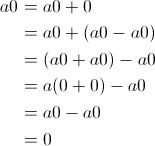
Additive Inverse of a Product
This property says that the multiplicative inverse of a product is equal to the product of one of the real numbers and the other one's inverse. that The first equality follows by the property of the additive identity. The second equality follows from the property of additive inverses. For the third, we use additive associativity. In the fourth, we use the distributive property. The fifth follows from the property of additive inverses. The sixth follows from the multiplication by zero property that we derived above. The seventh and final follows from the property of the additive identity. By commutativity, we have (-a)b = -(ab) too.
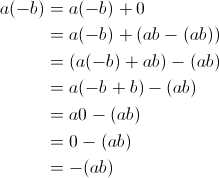
Commutativity of Inverses
This property says that multiplicative and additive inverses commute. The first equality follows from the additive identity. The second follows from additive inverses. The third follows from additive associativity. The fourth follows from the multiplicative identity. The fifth follows from multiplicative inverses. The sixth follows from the distributive property. The seventh follows from the additive inverse of a product that was proven above. The eight follows from multiplicative inverses. The ninth follows from additive inverses. The tenth follows from the multiplication by zero that was proven above. The eleventh and final equality follows from the additive identity.
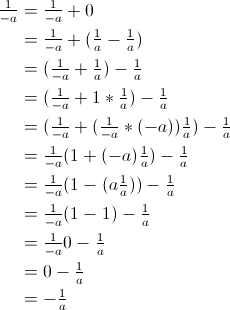
Additive Inverse of a Sum
This property says that the sum of additive inverses is the additive inverse of the sum. The first equality follows from the additive identity. The second follows from additive inverses. The third follows from additive associativity. The fourth follows from additive commutativity. The fifth follows from additive associativity. The sixth follows from additive inverses. The seventh follows from the additive identity. The eighth follows from additive inverses. The ninth follows from the additive identity.
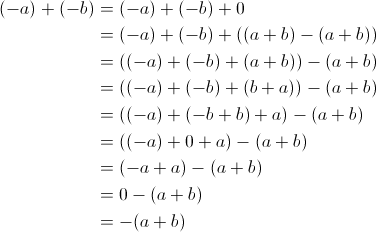
Multiplicative Inverse of a Product
This property says that the product of multiplicative inverses is the multiplicative inverse of the product. The first equality follows from the multiplicative identity. The second follows from multiplicative inverses. The third follows from multiplicative commutativity. The fourth follows from multiplicative associativity. The fifth follows from multiplicative inverses. The sixth follows from the multiplicative identity. The seventh follows from the multiplicative inverses. The eighth follows from the multiplicative identity.
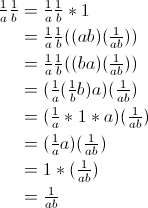
Additive Inverse of an Additive Inverse
This property says that the additive inverse of an additive inverse is the original element. The first equality follows from the additive identity. The second follows from additive inverses. The third follows from additive associativity. The fourth follows from additive inverses. The fifth follows from the additive identity.
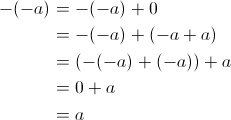
Multiplicative Inverse of a Multiplicative Inverse
This property says that the multiplicative inverse of an multiplicative inverse is the original element. The first equality follows from the multiplicative identity. The second follows from multiplicative inverses. The third follows from multiplicative associativity. The fourth follows from multiplicative inverses. The fifth follows from the multiplicative identity.
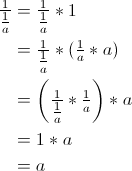
© 2007–2024 XoaX.net LLC. All rights reserved.
